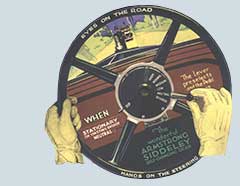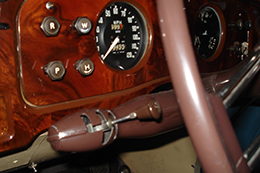The Preselector Gearbox
Armstrong Siddeley is synonymous with the preselector gearbox. The Wilson Preslector Gearbox was used in Amrstrong Siddeley models from 1928 until 1958, with many technical advancements made along the way. At first people are wary of this device where one moves a lever but no gears change until a pedal is depressed. However after a short time its use becomes second-nature and a most relaxing driving style is established. Below is a brief description of the preselector gearbox as used in the Armstrong Siddeley.
Drivers of modern cars with manual transmissions need little skill to change gears smoothly and silently. This is because of a wonderful device called synchromesh. This equalises the speed of the components as each gear is selected. Prior to the development of synchromesh in the 1930s, drivers of most cars had to contend with so called crash gearboxes. Drivers had to display considerable skill when changing gear if embarrassing grating noises were to be avoided, particularly when changing down, for example, from top to second. This required double-declutching, a process in which the clutch was momentarily released as the gearlever passed through neutral. The engine speed was increased at this point, in an effort to bring the soon to be meshed gears to the appropriate speed.
In 1928 Armstrong Siddeley introduced the preselector gearbox. As its name implied, it allowed the driver to select a gear in advance. The control consists of an engagement pedal that takes the place of the clutch pedal, and a selector lever mounted in a dial on the steering column. The dial is marked to indicate top, third, second, first, neutral and reverse positions. The lever selects the gear while the pedal accomplishes the actual gear change. The photograph to the right featured in an Armstrong Siddeley advertisement depicts the change lever on the centre of the steering hub in what appears to be a 1928 20HP.
In the 1952 Sapphire, the lever was replaced by a steering-column-mounted so-called electric-arm containing a miniature gearlever and a gear pattern that replicates that of a conventional 4-speed manual floor shift.
 |
 |
In this system, electric solenoids rather than a mechanical linkage operated the gearbox.This system was known as “preselectric” reflecting the combination of electric actuation and a preselector gearbox. The last Armstrong Siddeley so fitted was the Mk2 Sapphire.
The preselector gearbox may be viewed as a forerunner of today's automatic gearbox that is standard on the vast majority of current vehicles. Both transmissions rely on what are referred to as planetary gear sets and clutches to transmit drive from the engine to the differential and hence to the wheels. It is also ironic that today, virtually all modern automatic transmissions are fitted with an override to allow the driver to change up or down in a way not too dissimilar to the Armstrong Siddeley preselector gearbox.
You can get detailed information about the gearbox here. A comprehensive handbook is also available for purchase.
Related pages


